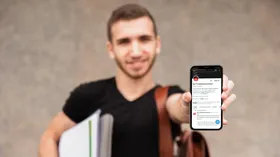How does science communication work in the virtual teacher's lounge “Twitter-Lehrerzimmer”, who tweets what, and how? And what research findings actually reach the classroom? This project delves into the dynamics of the German speaking Twitter teacher's community and provides insights for successful science practice transfer on social media.
Overview
Duration: since 2022
Funding: BMBF & KMK
Subsidy: 48 420 Euro
Principal Investigator: Prof. Doris Holzberger

Whether in the teacher's lounge or on social media, teachers are constantly in exchange with each other. They not only discuss their own experiences but also communicate scientific knowledge. For the virtual teacher's lounge, this means a huge, cross-school community and countless tweets and posts about studies and research findings in the field of research on learning and instrauction. But how does science practice transfer work in this large virtual teacher's lounge on social platforms, and what achieves reach?
The project Knowledge transfer in the #twlz examines who disseminates research findings within the framework of the Twitter teacher's lounge, how users present them, and whether teachers actually implement them in their everyday school life. So, what proves to be effective in terms of science communication in the context of social media? To investigate this, the project follows three steps.
Who tweets about scientific evidence?
The first step focuses on the users of the Twitter teacher's lounge. A network analysis is used to identify active and influential actors based on the reach of scientific tweets. Therefore, activities such as replies, retweets, quotes, and mentions by other users serve as measures of reach. As part of the network analysis, categories and communities of users participating in the virtual teacher's lounge are also identified, whether they are teachers, educational experts, or educational institutions.
What do users in the teacher's lounge tweet about?
In the second step of the project, the focus is on the tweets themselves: a content analysis provides an overview by differentiating between scientific tweets, teaching concepts and materials, and experiential reports. At the same time, popular hashtags and language patterns can be identified. Quality criteria such as emojis, links, and multimedia content are also considered in the analysis, painting a picture of how scientific results are presented in the Twitter teacher's lounge.
What happens online, stays online?
As a last step, interviews with teachers provide insights into the extent to which the scientific knowledge communicated in the virtual teacher's lounge actually finds its way into the classroom. The goal is to determine the knowledge sources used by teachers and the dimensions of transfer. In the interviews, teachers also answer questions about selected example tweets from the Twitter teacher's lounge, which were created based on predefined quality criteria. They then rate these tweets in terms of content quality, attractiveness, and usefulness for their own teaching.
The project Knowledge transfer in the #twlz contributes to creating scientifically informed teaching and provides indications of what successful science practice transfer can look like on social media. Ultimately, this can also optimize the quality of teaching and schools in the long term.